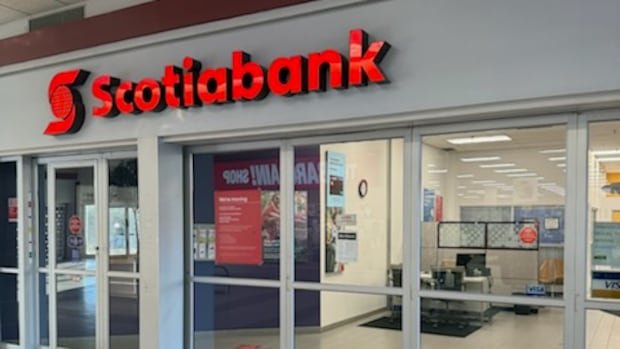The mayor of Marathon, Ontario, says he is concerned about the impact the pending closure of the city’s only remaining physical bank branch will have on the community.
Scotiabank recently announced it would close its Marathon and Red Lake branches next spring.
“After careful consideration, we have made the difficult decision to move our services at our Red Lake branch to our Kenora branch on May 5, 2026 and our Marathon Center Mall branch to the Arthur and Parkdale branch. [in Thunder Bay] on May 12, 2026,” a Scotiabank spokesperson said in a statement to CBC News.
Marathon Mayor Rick Dumas said one of his city council members informed him of the closure last week.
And while Dumas said he has been contacted by Scotiabank representatives to help residents transition from in-person banking to online banking, he is still concerned about the impact the closure will have.
“We see these banks making enormous amounts of profits,” Dumas said. “Then I read the statement from the president of Scotiabank that clearly said that… ‘our long-term objectives and priorities are to drive Scotiabank’s long-term profitability for shareholders.'”
“More concerned about the bank’s shareholders than the consumers who are contributing billions of dollars to the bank through mortgages and businesses and checking account holders and the service fees we all pay,” Dumas said. “It’s kind of frustrating from a small community standpoint, as a mayor, to lose your last financial institution, but we still have no recourse.”
Concern for older people and companies
Dumas said seniors in Marathon may have difficulty with the shift to online-only banking, and the change will also cause problems for businesses in the community.
“How do they get their money to carry out their transactions?” said. ‘”They will have to pay a service from a transfer company, such as Garda World or Brinks, to come to the community.”
“The larger stores… will do that, like the Canadian Tires of the world, the independent stores, the grocery stores, they will pay for that service,” Dumas said. “They have no choice. They need to get cash. And that’s happening right now in our communities. They get cash once a week.”
In fact, Dumas said, those stores are becoming banks for smaller businesses, who will go to a larger store to change when the bank branch is closed, so they can continue operating.
“Our bank has already seen reduced hours over the last year,” Dumas said, adding that a Scotiabank representative said there might be an opportunity to offer a course in Marathon to help customers become more comfortable with online banking.
“I know it’s all about profitability, but when does it end?” Dumas said.
In the statement, Scotiabank said the decision is due to changes in customer preferences as more and more daily banking operations are conducted digitally.
“We are communicating this change to all affected customers and will work with them to ensure a smooth transition”
The North Shore community of Schreiber, 200 kilometers northeast of Thunder Bay, also lost access to personal banking earlier this year. Resident Alison McLaughlin said it has a direct impact on the community. `
“For small businesses that get change, they can get dollar bills out of the bank machine, but they can’t get quarters or dollar bills and the things they need for change. So we’re losing cash flow,” McLaughtlin said. “It also affects, say, church dues and bazaars. When they want to sell things in bazaars, they have to have cash.”
Managing bank branches is expensive
Jerry Buckland, a professor of economics and international development at Winnipeg-based Canada Mennonite University who has studied access to finance and banking services, said physical branches are the most expensive part of banking.
“They’re trying to encourage customers to go online, to do more online banking,” he said. “And on the one hand, there is the response of banks to market conditions and technological change, but then we have the consequences for consumers, businesses and communities.”
Buckland said branches in areas where residents have lower incomes and tend to use low-end services that don’t generate as much profit for the bank may be the most likely to see cuts.
In the meantime, Buckland said, some will find it easier to move to online banking than others.
“The least vulnerable clients are the ones that are most likely to make that migration, because they have a computer, they have the Internet and they are comfortable with those information systems,” he said. “But for some people who don’t have access to that kind of infrastructure, and maybe aren’t comfortable with that kind of infrastructure, it’s more of a barrier.”
There is also the issue of online scams targeting more vulnerable people, as well as attracting third-party loan providers, Buckland said.
“Maybe you don’t have access to a bank and you can’t get a credit card or a line of credit or some type of loan to help you through a difficult time,” he said. “And you see payday loans being marketed online or installment loans.”
“That might lead you to opt for one of those products,” Buckland said. “Even when they are regulated, they are quite risky products, but if they are offered by a company outside your jurisdiction or outside your country, then the risk is great.”








